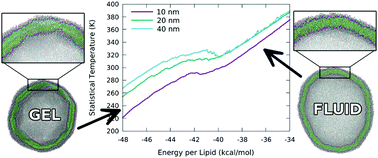Simulation of fluid/gel phase equilibrium in lipid vesicles†
Abstract
Simulation of single component dipalmitoylphosphatidylcholine (DPPC) coarse-grained DRY-MARTINI lipid vesicles of diameter 10 nm (1350 lipids), 20 nm (5100 lipids) and 40 nm (17 600 lipids) is performed using statistical temperature molecular dynamics (STMD), to study finite size effects upon the order–disorder gel/fluid transition. STMD obtains enhanced sampling using a generalized ensemble, obtaining a flat energy distribution between upper and lower cutoffs, with little computational cost over canonical molecular dynamics. A single STMD trajectory of moderate length is sufficient to sample 20+ transition events, without trapping in the gel phase, and obtain well averaged properties. Phase transitions are analyzed via the energy-dependence of the statistical temperature, TS(U). The transition temperature decreases with decreasing diameter, in agreement with experiment, and the transition changes from first order to borderline first-second order. The size- and layer-dependence of the structure of both stable phases, and of the pathway of the phase transition, are determined. It is argued that the finite size effects are primarily caused by the disruption of the gel packing by curvature. Inhomogeneous states with faceted gel patches connected by unusual fluid seams are observed at high curvature, with visually different structure in the inner and outer layers due to the different curvatures. Thus a simple physical picture describes phase transitions in nanoscale finite systems far from the thermodynamic limit.



 Please wait while we load your content...
Please wait while we load your content...